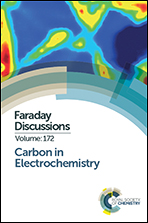Effects of structural disorder and surface chemistry on electric conductivity and capacitance of porous carbon electrodes†
Abstract
This article reports on changes in electric double layer charge storage capacity as a function of surface chemistry and graphitic structure of porous carbon electrodes. By subjecting 20 nm to 2.0 μm sized carbide-derived carbons (CDCs) synthesized at 800 °C to high-temperature vacuum annealing at 700–1800 °C, we produce three-dimensional internal surface architectures with similar pore sizes and volumes but divergent surface chemistry and wall graphitization. Annealing increases carbon ordering and selectively removes functional groups, and both transformations affect conductivity and wettability. Contrary to an expected increase in gravimetric capacitance, we demonstrate no increases in charge storage despite increased conductivity and pore accessibility. At the same time, annealing improves the charge/discharge rates in EMIm-TFSI ionic liquid electrolyte. The annealing process eliminates faradaic reactions that limit the voltage window, but potentially accelerates catalytic breakdown of the ions themselves. We therefore corroborate the theory that surface groups and defects in the graphitic structure act as dopants that allow facile movement of ions into pores, improve screening in the superionic state, and affect the quantum capacitance contribution from the carbon structure.
- This article is part of the themed collection: Carbon in Electrochemistry

 Please wait while we load your content...
Please wait while we load your content...